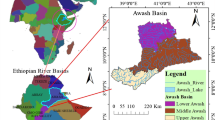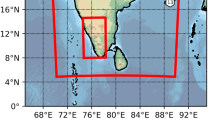Abstract
In this study, bias-corrected daily rainfall data of eight global climate models (GCMs) was used as input for a hydrologic model (Hydrological Engineering Center - Hydrological Modeling System (HEC-HMS)) to simulate daily streamflow in the Upper Ayerawaddy River basin (UARB), Myanmar. Monthly, seasonal, annual, and decadal mean flows, calculated for the baseline (1975–2014), were compared with projections for future periods (2040s: 2021–2060 and 2080s: 2061–2100) under two Representative Concentration Pathways (RCP 4.5 and RCP 8.5). The spread of low flows (10th and 25th percentile of daily flows) and high flows (75th, 90th, and 100th percentiles) were analyzed for each period. The ensemble of GCMs indicates an increase in mean monthly (except in October and November), seasonal (except post-monsoon), annual, and decadal rainfalls and corresponding flows in the UARB. Future low flows are expected to have high variability while high flows are expected to have higher means than that of baseline. The density distribution analysis of baseline and future flows reveals that future periods are likely to experience an increase in the magnitude of mean flows but a decrease in variability. Rainfall extremes indicated by 1-day maximum rainfall, 5-day consecutive maximum rainfall, and the number of extreme rainfall days reveals frequent wetter extremes in the UARB under future climate conditions. Extreme floods, as estimated by the frequency analysis of daily flows, are also expected to become more frequent during the future periods. These changes in flows can be attributed solely to climate change since the analyses did not account impacts of possible land use change and water resources development in the UARB. This study is a good starting point to assess future flows, and further research is recommended to address the limitations of this study for improved understanding and assessments that will prove useful for planning purposes in the study area.











Similar content being viewed by others
References
ADB (2009) is a report of ADB. Accessed from https://www.adb.org/sites/default/files/publication/27531/building-climate-resilience-agriculture-sector.pdf
Aryal A, Shrestha S, Babel MS (2018) Quantifying the sources of uncertainty in an ensemble of hydrological climate-impact projections. Theor Appl Climatol:1–17
Boori MS, Choudhary K, Evers M, Paringer R (2017) A review of food security and flood risk dynamics in central dry zone area of Myanmar. Procedia Eng 201:231–238
Brakenridge G, Syvitski J, Niebuhr E, Overeem I, Higgins S, Kettner A, Prades L (2017) Design with nature: causation and avoidance of catastrophic flooding, Myanmar. Earth-Sci Rev 165:81–109
Charan Pattnayak K, Kar SC, Kumari Pattnayak R (2015) Projections of rainfall and surface temperature from CMIP5 models under RCP4. 5 and 8.5 over BIMSTEC countries. In EGU general assembly conference abstracts(Vol. 17). Accessed from http://meetingorganizer.copernicus.org/EGU2015/EGU2015-556.pdf
Davies R (2018) is the reference for online news article from "floodlist" titled Myanmar-Deadly Floods and Landslides Strike Mohnyin District, Kachin State. Accessed from http://floodlist.com/asia/myanmar-floods-landslides-strike-kachin-state-june-2018
Defourney P, Vancutsem C, Bicheron P, Brockmann C, Nino F, Schouten L, Leroy M (2006) GLOBCOVER: a 300 m global land cover product for 2005 using Envisat MERIS time series. In Proceedings of the ISPRS commission VII mid-term symposium: remote sensing: from pixels to processes. Accessed from http://citeseerx.ist.psu.edu/viewdoc/download?doi=10.1.1.116.1909&rep=rep1&type=pdf
Easterling DR, Meehl GA, Parmesan C, Changnon SA, Karl TR, Mearns LO (2000) Climate extremes: observations, modeling, and impacts. Science 289:2068–2074
Endo N, Matsumoto J, Lwin T (2009) Trends in precipitation extremes over Southeast Asia. Sola 5:168–171
FAO (2016) is a report of FAO Aquastat. Accessed from http://www.fao.org/nr/water/aquastat/countries_regions/MMR/MMR-CP_eng.pdf
Garba H, Ismail A, Tsoho U (2013) Fitting probability distribution functions to discharge variability of Kaduna River. Int J Mod Eng Res 3:2848–2852
Ghimire U (2016) Analysis of historical and future climatic and hydrologic extremes in the Upper Ayerawaddy River Basin in Myanmarth. Asian Institute of Technology, Pathumthani
Gosain AK, Rao S, Basuray D (2006) Climate change impact assessment on hydrology of Indian river basins. Current science, 90(3), pp.346–353. Accessed from https://www.researchgate.net/profile/Ashvani_Gosain/publication/237268322_Climate_Change_Impact_Assessment_on_Hydrology_of_Indian_River_Basins/links/00b4953bd6fce3a881000000
Gudmundsson L, Bremnes J, Haugen J, Engen-Skaugen T (2012) Downscaling RCM precipitation to the station scale using statistical transformations–a comparison of methods. Hydrol Earth Syst Sci 16:3383–3390
Horton R, De Mel M, Peters D, Lesk C, Bartlett R, Helsingen H, Bader D, Capizzi P, Martin S, Rosenzweig C (2016) is a technical report on "Assessing the Climate Risk of Myanmar". Accessed from https://themimu.info/sites/themimu.info/files/documents/Report_Assessing_Climate_Risk_in_Myanmar_-_Technical_Report_Mar2017.pdf
Htway O, Matsumoto J (2011) Climatological onset dates of summer monsoon over Myanmar. Int J Climatol 31:382–393
IPCC (2014) Climate Change 2014 – Impacts, Adaptation and Vulnerability: Part B: Regional Aspects: Working Group II Contribution to the IPCC Fifth Assessment Report. Cambridge: Cambridge University Press. https://doi.org/10.1017/CBO9781107415386
IWMI (2019) is based on an online webpage of IWMI CGIAR. Accessed from http://www.iwmi.cgiar.org/where-we-work/asia/southeast-asia/myanmar/key-water-issues/
Kar AK, Winn LL, Lohani A, Goel N (2011) Soft computing–based workable flood forecasting model for Ayeyarwady River Basin of Myanmar. J Hydrol Eng 17:807–822
Kattelus M, Rahaman MM, Varis O (2015) Hydropower development in Myanmar and its implications on regional energy cooperation. Int J Sustain Soc 7:42–66
Kay A, Davies H, Bell V, Jones R (2009) Comparison of uncertainty sources for climate change impacts: flood frequency in England. Clim Chang 92:41–63
Kendall MG (1948) Rank correlation methods. Oxford, England: Griffin
Khaing M (2015) Assessing Climate Change Impacts on Hydropower Generation in the Myitnge River Basin, Myanmar. Conference paper presented during Hydropower 2015 conference. Accessed from http://www.ich.no/Opplastet/Dokumenter/Hydropower15/khaing_myanmar.pdf
Krause P, Boyle D, Bäse F (2005) Comparison of different efficiency criteria for hydrological model assessment. Adv Geosci 5:89–97
Kreft S, Eckstein D, Junghans L, Kerestan C, Hagen U (2014) is a briefing paper of Global Climate Risk Index. Accessed from http://www.indiaenvironmentportal.org.in/files/file/global%20climate%20risk%20index%202015.pdf
Krysanova V, Vetter T, Eisner S, Huang S, Pechlivanidis I, Strauch M, Gelfan A, Kumar R, Aich V, Arheimer B (2017) Intercomparison of regional-scale hydrological models and climate change impacts projected for 12 large river basins worldwide—a synthesis. Environ Res Lett 12:105002
Lehner B, Verdin K, Jarvis A (2006) HydroSHEDS technical documentation, version 1.0. World Wildlife Fund US, Washington, DC, pp 1–27
Mann HB (1945) Nonparametric tests against trend. Econometrica: Journal of the Econometric Society, pp.245–259. https://doi.org/10.2307/1907187, https://www.jstor.org/stable/1907187
Maraun D (2013) Bias correction, quantile mapping, and downscaling: revisiting the inflation issue. J Clim 26:2137–2143
Mendelsohn R, Dinar A, Williams L (2006) The distributional impact of climate change on rich and poor countries. Environ Dev Econ 11:159–178
Moriasi DN, Arnold JG, Van Liew MW, Bingner RL, Harmel RD, Veith TL (2007) Model evaluation guidelines for systematic quantification of accuracy in watershed simulations. Trans ASABE 50:885–900
Nan Y, Bao-hui M, Chun-kun L (2011) Impact analysis of climate change on water resources. Procedia Eng 24:643–648
O’Gorman PA (2015) Precipitation extremes under climate change. Curr Clim Change Rep 1:49–59
Prudhomme C, Davies H (2009) Assessing uncertainties in climate change impact analyses on the river flow regimes in the UK. Part 2: future climate. Clim Chang 93:197–222
Sein K, Chidthaisong A, Oo K (2018) Observed trends and changes in temperature and precipitation extreme indices over Myanmar. Atmosphere 9:477
Sen PK (1968) Estimates of the regression coefficient based on Kendall’s tau. J Am Stat Assoc 63:1379–1389
Shrestha S, Htut AY (2016) Land use and climate change impacts on the hydrology of the Bago River basin, Myanmar. Environ Model Assess 21:819–833
Shrestha B, Babel M, Maskey S, Van Griensven A, Uhlenbrook S, Green A, Akkharath I (2013) Impact of climate change on sediment yield in the Mekong River basin: a case study of the Nam Ou basin, Lao PDR. Hydrol Earth Syst Sci 17(1)
Soe MK (2018) is an online web news article. Accessed from http://www.globalnewlightofmyanmar.com/utilization-water-resources-myanmar/
Sok K, Oeurng C (2016) Application of HEC-HMS model to assess streamflow and water resources availability in Stung Sangker catchment of Mekong’Tonle Sap lake basin in Cambodia. https://doi.org/10.20944/preprints201612.0136.v1, Accessed from https://www.preprints.org/manuscript/201612.0136/v1
Sun X, Mein R, Keenan T, Elliott J (2000) Flood estimation using radar and raingauge data. J Hydrol 239:4–18
Tebaldi C, Hayhoe K, Arblaster JM, Meehl GA (2006) Going to the extremes. Clim Chang 79:185–211
Van Ty T, Sunada K, Ichikawa Y, Oishi S (2012) Scenario-based impact assessment of land use/cover and climate changes on water resources and demand: a case study in the Srepok River Basin, Vietnam—Cambodia. Water Resour Manag 26:1387–1407
Vetter T, Reinhardt J, Flörke M, van Griensven A, Hattermann F, Huang S, Koch H, Pechlivanidis IG, Plötner S, Seidou O (2017) Evaluation of sources of uncertainty in projected hydrological changes under climate change in 12 large-scale river basins. Clim Chang 141:419–433
WEPA (2005) is an online webpage of WEPA. Accessed from http://www.wepa-db.net/policies/state/myanmar/myanmar.htm
Wilby RL, Harris I (2006) A framework for assessing uncertainties in climate change impacts: Low-flow scenarios for the River Thames, UK. Water Resour Res 42
Yazid M (2015) Regional observed trends in daily rainfall indices of extremes over the Indochina Peninsula from 1960 to 2007. Climate 3:168–192
Yue S, Ouarda T, Bobée B, Legendre P, Bruneau P (1999) The Gumbel mixed model for flood frequency analysis. J Hydrol 226:88–100
Acknowledgements
The authors would like to thank the RIMES (Regional Integrated Multi hazard Early Warning Systems) for providing their data on rainfall and discharge through their project on “Development and Implementation of User-Relevant End-to-End Flood Forecast Generation and Application System for Myanmar” to the first author during his internship at RIMES. Special thanks to the Director General of DMH, Myanmar, Dr. Anshul Agarwal (senior hydrologist, RIMES), and Dr. Pooja Sancheti for their support.
Author information
Authors and Affiliations
Corresponding author
Additional information
Publisher’s note
Springer Nature remains neutral with regard to jurisdictional claims in published maps and institutional affiliations.
Rights and permissions
About this article
Cite this article
Ghimire, U., Babel, M.S., Shrestha, S. et al. A multi-temporal analysis of streamflow using multiple CMIP5 GCMs in the Upper Ayerawaddy Basin, Myanmar. Climatic Change 155, 59–79 (2019). https://doi.org/10.1007/s10584-019-02444-3
Received:
Accepted:
Published:
Issue Date:
DOI: https://doi.org/10.1007/s10584-019-02444-3




